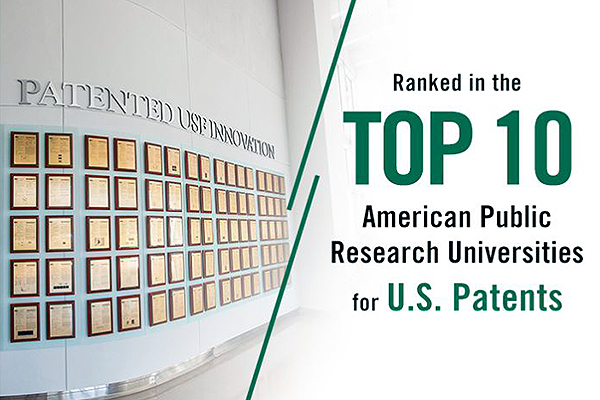USF ranks in the Top 10 of American public universities, Top 20 of universities worldwide, in securing new U.S. utility patents
For the seventh consecutive year, the University of South Florida stands with the world’s top universities in inventing new technologies and devices that have been granted a U.S. utility patent, according to rankings released June 4, 2019 by the National Academy of Inventors and the Intellectual Property Owners Association.
Based on new patents secured during the 2018 calendar year, USF is seventh among American public research universities and 16th among all universities worldwide in generating new patents. The ranking places USF in rare company among the more than 1,000 academic institutions generating new, novel and useful inventions granted intellectual property protection from the U.S. Patent and Trademark Office.
The 96 patents that USF inventors earned in 2018 was tops for any Florida university, and span a wide array of technologies, from nanotherapy to clean energy solutions to sustainable water technologies.
Among the patented projects was nanoscale particles designed to improve drug delivery in the fight against central nervous system diseases. A team of USF Health Morsani College of Medicine faculty, led by neurologist Juan Sanchez-Ramos, MD, PhD, developed a new method that safely delivers genes, or small interfering RNA, into the brain by inhalation using nanoparticles. In addition to Dr. Sanchez-Ramos, the inventors were Vasyl Sava, PhD, assistant professor; Shijie Song, MD, assistant professor; Shyam Mohapatra, PhD, distinguished professor; and Subhra Mohapatra, PhD, professor.
The nanoparticles provide more effective therapeutic delivery from nose to brain, without the need for invasive neurosurgical injection. Also, the nanoparticles can be visualized by MRI and other imaging techniques, allowing clinicians and researchers to observe uptake and distribution of the therapy. The current method of delivering therapeutic genes or viral vectors into the brain is by minimally invasive neurosurgical injection. For diseases like Huntington’s, which involves the entire brain, injection into multiple brain regions is not feasible.
The NAI and IPO have published the Top 100 Worldwide Universities Granted U.S. Utility Patents report annually since 2013. View the complete list of universities here.

